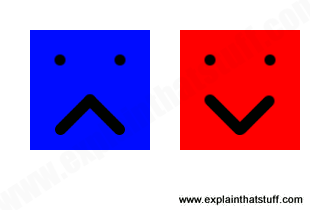
Lenticular printing
by Chris Woodford. Last updated: October 20, 2022.
Every day, there are hundreds—perhaps even thousands—of advertising messages knocking on your head trying to gain access to the part of your brain that decides to buy things. With so much money at stake, it's hardly surprising that advertisers go to such extraordinary lengths to catch our attention. The only trouble is, our brains habituate: they quickly get used to seeing the same thing over and over again. So the advertisers have to keep thinking of new tricks to stay one step ahead. One of their latest ideas is to print posters, magazines, and book covers with lenticulars—images that seem to change as you move your head. Let's take a closer look at how they work!
Photo: The LEGO® robot image on the cover of my book Cool Stuff Exploded changes as you tilt it back and forth. A plastic lenticular insert shows you one of two different images depending on which side you look from.
Sponsored links
Contents
What have lentils got to do with it?

Photo: Lentils like this one gave lenses their name. Convex lenses bulge out in the middle like lentils, while concave lenses "cave in" in the middle and bulge out at the edges.
Nothing! Lentils are tiny orange, green, or brown pulses popular with vegetarians and—no—they have nothing to do with how book covers work. The connection between "lentil" and "lenticular" is simply a matter of words. Lenticulars are so-called because they use lenses, which are pieces of plastic or glass that bend (or "refract") light to make things look bigger or smaller. Lenses got their name because some of them just happen to look a bit like lentils! You can find more in our main article on lenses (we even tell you how to make a lens of your own, in about 5 seconds flat, from a drop of water).
How do you make a lenticular?
Here's the cover of my book (from the top photo) in close-up. Now you can see the individual lenticles. Each one is a hemispherical plastic lens that magnifies only one of the sliced images underneath it, depending on where you're eyes are in relation to the book cover. Different lenticulars have what's called a different pitch, which is the number of lenticles per inch (LPI). They also work differently at different distances from the viewer. Both these factors—the pitch and the viewing distance—have to be taken into account to make a convincing lenticular print.

How do you make something like this? You take your two different images and load them into a computer graphics program. The program cuts each image into dozens of thin strips and weaves them together so the strips from the first image alternate with the strips from the second. This process is called interlacing. If you look at the doubled-up image printed this way, it's just a horribly confusing mess, but not for long! Next, you place a transparent plastic layer on top of the doubled-up image. This is made of dozens of separate thin, hemi-spherical lenses called lenticles. These refract (bend) the light passing through them so, whichever side you're looking from, you see only half the printed strips. Move your head back and forth and the image flips back and forth too like a kind of "visual see-saw".
For all this to work properly, everything has to be printed with incredible precision. The lenticles have to be exactly the same size as the printed strips underneath them and lined up with them exactly. Not only that, the image has to be adjusted and printed so that it looks exactly right when viewed through a certain piece of lenticular plastic (with a certain "pitch"—or number of lenticles per inch) at a certain viewing distance. (That's a fiddly technical process and I won't go into the details here, but you can find out more in the articles and videos in the further reading section below.)

Artwork: Who invented lenticular printing? One strong contender is Walter Hess of Rapperswil, Switzerland. Here's a drawing from his 1912-filed patent clearly outlining the method of lenticular printing still used to this day. A lenticular surface (1) based on segments of cylindrical lenses (2) diverts light rays in different directions. Looking from point (3), you see the image at point (5); looking from point (4), you see the alternate image at point (6). Artwork from US Patent #1,128,979: Stereoscopic picture by Walter Hess, granted February 16, 1915, courtesy of US Patent and Trademark Office.
How many images can you have?
Nothing says lenticulars have to flip back and forth between just two images: some have as many as 20 different images or "frames" (as they're sometimes called, using the language of moviemaking). You could have half a dozen different images designed to point in slightly different directions, so an advertising poster slowly and subtly changes its message as you walk past! You can also use lenticulars to create amazing 3D images similar to holograms.

Photo: One of the problems with lenticulars is that, just at the point where one image should flip to another, you can see both images at once. Sometimes this works in your favour; sometimes it's jarring and undermines the illusion. In this example, you can see a lenticular of an iPod that shows the normal (external) case and the (internal) circuit board. From a certain angle, you can see both images at once.




